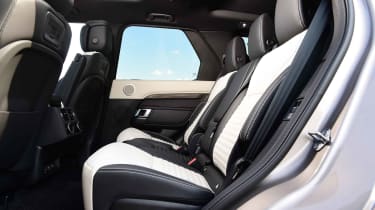Land Rover Discovery - Practicality, comfort and boot space
The Land Rover Discovery’s interior is luxurious and cavernous, offering exactly what you want from a large, upmarket seven-seat SUV

With all seven seats upright, the Land Rover Discovery serves up 172 litres of luggage space – that’s what you’d expect from a tiny city car, and much smaller than the 356-litres provided behind the Volvo XC90.
The sheer size of the Discovery does pay dividends in the end, because luggage capacity increases to a huge 922 litres with the rearmost seats folded down, meaning there’s more luggage room on offer than in its main rivals.
There’s a van-like 1,997 litres of room with all seats folded (which explains why there is a Commercial version available), which certainly helped us during our long-term testing of a Discovery where we completed plenty of trips to the tip and moved a fair amount of furniture in one. So, no matter how big your family is, the car caters for them with plenty of comfort and lots of versatility.
Our only minor gripe is that, while you fold the back rests of the middle row seats electrically, you have to slide the seat bases manually to climb into the very back. The aperture it leaves isn’t huge, but it's adequate when compared to the tighter Audi Q7 and XC90.
Size
At nearly five metres long and more than two metres wide, the Discovery feels vast on the road. However, it’s not too much larger than the XC90, while it’s actually shorter than the Q7.
Used - available now

2023 Land Rover
Discovery
25,537 milesAutomaticDiesel3.0L
Cash £43,700
2013 Land Rover
Discovery
89,000 milesAutomaticDiesel3.0L
Cash £16,995
2019 Land Rover
Discovery
59,930 milesAutomaticDiesel3.0L
Cash £27,899
2019 Land Rover
Discovery
75,025 milesAutomaticDiesel3.0L
Cash £32,970The Land Rover’s tank-like feel on the road stems from its chassis setup, as it’s not quite as agile as either the Audi or Volvo. However, while this gives it a more cumbersome feel in corners, it’s also extremely relaxed and offers better use of space inside, given its footprint.
Leg room, head room & passenger space
No matter what configuration the seats are in, if you’re sat in the middle row there’ll be plenty of room – even with the bench slid all the way forward.
This gives third-row passengers even more space, and in this configuration, it’s really the only car in its class that can accommodate two fully grown adults in the rear in relative comfort. Shoulder room is good, while the Discovery’s traditional stepped roof also offers decent headroom in the very back. This is necessary because of the 'stadium' seating layout, where the back seats are mounted slightly higher than the ones in front of them to give a better view forward.
These cars will probably be bought by families, so it’s good to see that there are ISOFIX child seat tethering points on the front passenger seat, and on the outermost positions of the second row, that offer lots of versatility if you’ve got young children still in car seats. We just urge that you make sure the front passenger airbag does deactivate if you happen to put a child seat up front.
Boot
Provided the third row isn’t in place, the Discovery’s boot is huge. More importantly, though, it’s also a uniform shape. There’s are clever touches, too, such as a dedicated storage space for the load cover when you’re using all seven seats, and a gesture function (on the top trim level) to help when opening and closing the boot when your hands are full. Simply flick your foot under the bumper, and the boot should open or close.
One big change for this new Discovery is the lack of a split tailgate with a drop-down lower section that can double as a seat. However, Land Rover knows it’s something of a Disco trademark, so has come up with a neat solution.
The one-piece hatch opens, revealing an electrically operated flip-down ledge that can support up to 300kg. It adds yet another practical touch, and should mean owners of previous-generation Discos won’t have to sacrifice any usability when it comes to running this fifth-generation model.
Towing
All Discovery models have a maximum braked trailer towing weight of 3,500kg. That’s a lot more than the 2,700kg capacity of the best-performing BMW X5 xDrive50e.
The Towing Pack includes an electrically deployable tow bar, and the 13-pin electric point is located within easy reach. It also features an Advanced Tow Assist function where you can use the rotary dial from the Terrain Response system. Pull the dial up while reversing, and you can steer the car and caravan/trailer using the moving directional arrows on the screen that show where the car will go. We think that’ll be helpful for those who struggle with this task.










